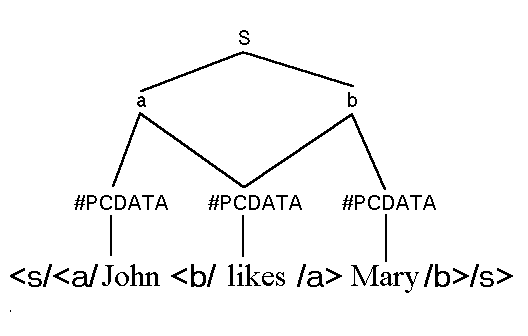
Claus Huitfeldt
Wittgenstein Archives
University of Bergen
Allegaten 27
Bergen, N-5007
Norway
Claus.Huitfeldt@hit.uib.no
http://www.hit.uib.no/claus/goddag.html
The success of SGML is based in part on the natural way in which SGML documents can be regarded as linearizations of trees using a notation essentially similar to labeled bracketing, and on the natural way in which the tree so represented can be interpreted as a parse tree or an abstract syntax tree for the grammar defined in the documents' document type definition (DTD). The close ties among grammar, tree structure, and linearization give SGML an intellectual coherence missing from some other markup schemes.
When it comes to overlapping structures, however, these notions cannot be applied with the same naturalness.
Therefore, a major challenge to any attempt to provide better support for markup of overlap is to provide not only a convenient file format for recording overlap, but also a notation for expressing constraints on documents with overlap, and plausible data structures for representing documents with overlap. In this paper we address the third of these problems.
Consider the following simple example of a document with overlapping structures:
<s/<a/ John <b/ likes /a> Mary /b>/s>
The sentence John likes Mary is tagged as a sentence (s). The words John likes are tagged as an a, and the words likes Mary as a b. Because the a and the b overlap, the document has no convenient representation in SGML, and no SGML-style tree can be drawn for it.
However, we can draw the containment relations among s, a, b, and the
words of the text in a natural way. The result is a graph like this:

The graph resembles a tree, but differs from a tree in that multiple parent nodes can contain the same child. The multiple parents of such a child are the elements which overlap in the original document; the child is the scope of the overlap. For our purposes, overlap is simply multiple parentage.
Graphs like the one just shown may be constructed for any document with overlapping structures. If a document has no overlaps, the graph reduces to a tree. If a document does have overlap, the corresponding graph will preserve as many of the characteristics of the document tree as possible.
Because the structure described is an acyclic directed graph in which nodes have ordered descendants, we refer to it as a General Ordered-Descendant Directed Acyclic Graph (GODDAG).
The GODDAG structure allows the markup in the source document to be interpreted in fairly straightforward graph-theoretical terms. The inheritance from parents to children of claims about properties can be interpreted just as it can be for a tree structure.
Since elements can have multiple parents, however, rules for multiple inheritance must be developed by the application or document type definition. Just as with trees, GODDAG structures provide simple ways to explain and think about overriding of inherited values and the coexistence of properties asserted of ancestors and descendants.
The rules of interpretation become more complex than those of standard SGML, precisely because the GODDAG structure is more complex than a tree.
When two elements overlap, they define three distinct regions dominated by one or the other of the overlapping elements, or both:
<a/ John <b/ likes /a> Mary /b>
If any one of the regions is empty, then the overlap is spurious: the document can be rewritten without overlap, without changing the interpretation of any character of the document:
<a/ <b/ likes /a> Mary /b>
<a/ John <b//a> Mary /b>
<a/ John <b/ likes /a> /b>
We define the function leafset as returning the set of leaf nodes dominated by a given non-leaf node. A GODDAG structure is clean (lacks spurious overlap) if the following conditions hold:
The major expected applications of the GODDAG structure include:
Possible extensions include:
Everything we say about SGML in this paper applies to XML as well. For overviews of overlap-related problems, see Barnard et al. 1988, Barnard et al. 1995, DeRose et al. 1990, Durand et al. 1996, Huitfeldt 1995, Renear et al. 1995, and chapter 31 of the TEI Guidelines. The optional CONCUR feature, which does allow for multiple concurrent hierarchies in SGML documents, is discussed in Sperberg-McQueen and Huitfeldt 1998.